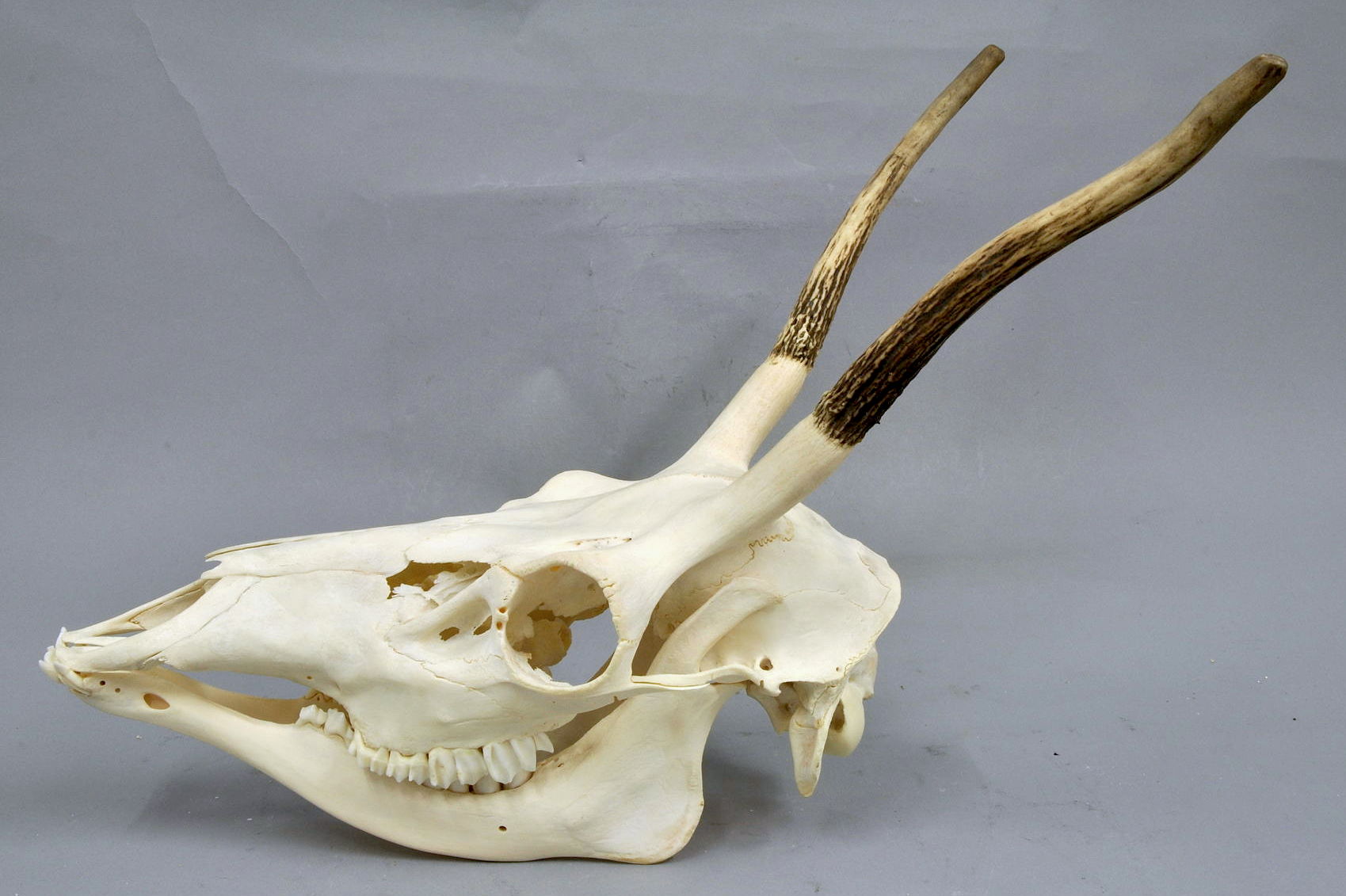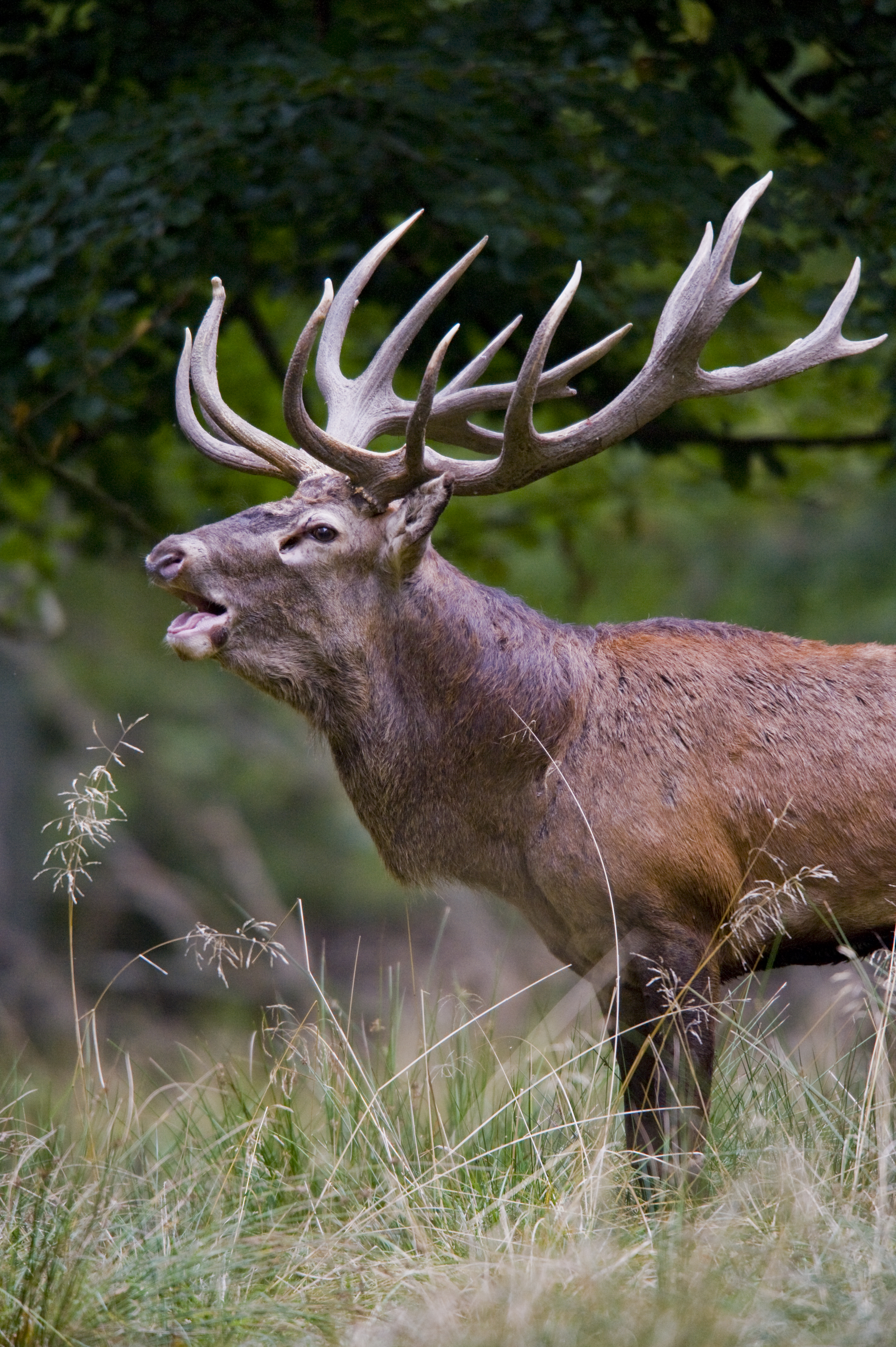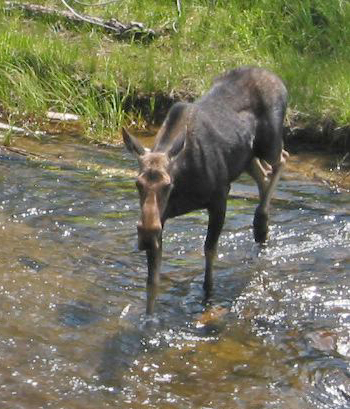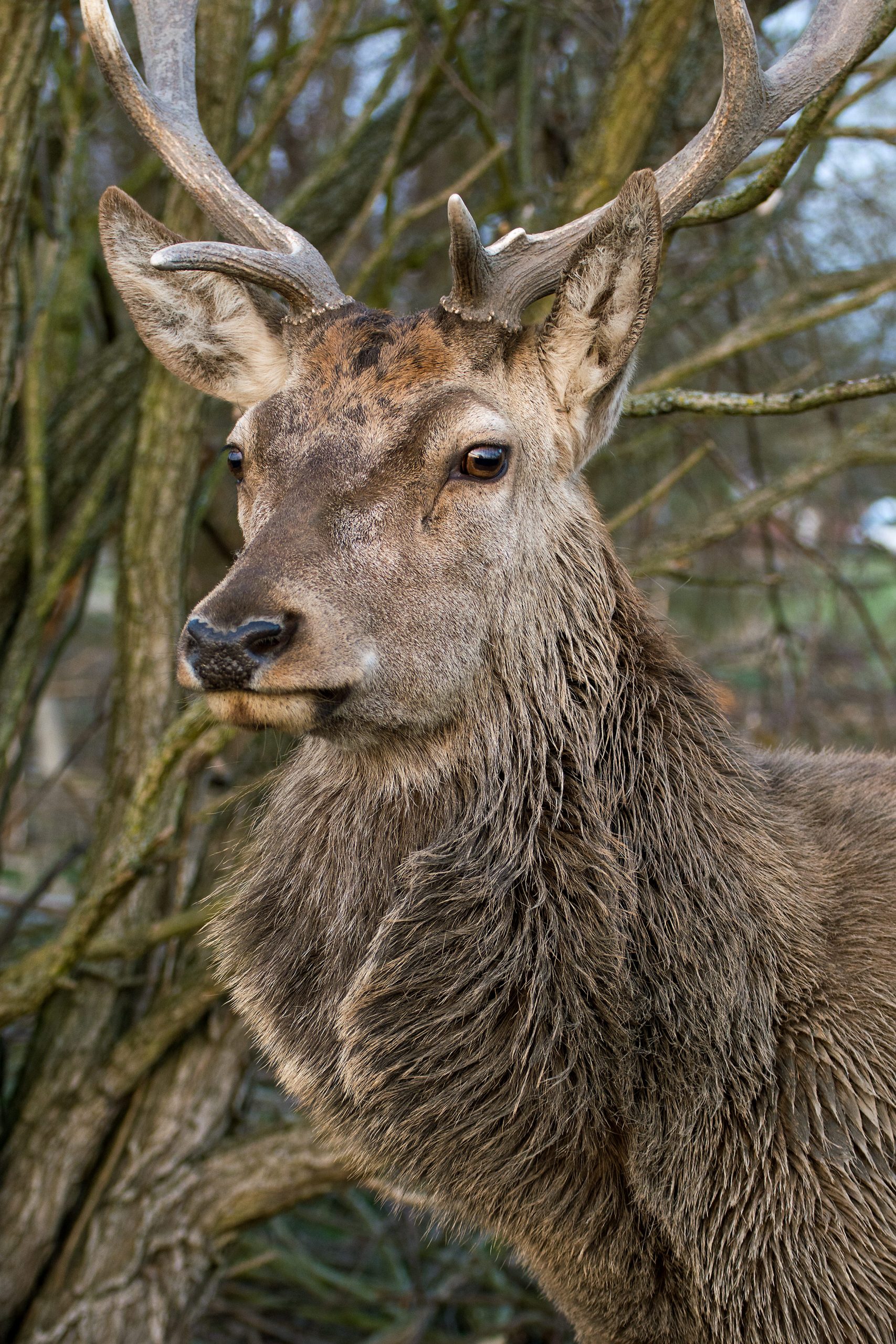|
Stag
A deer (: deer) or true deer is a hoofed ruminant ungulate of the family Cervidae (informally the deer family). Cervidae is divided into subfamilies Cervinae (which includes, among others, muntjac, elk (wapiti), red deer, and fallow deer) and Capreolinae (which includes, among others reindeer (caribou), white-tailed deer, roe deer, and moose). Male deer of almost all species (except the water deer), as well as female reindeer, grow and shed new antlers each year. These antlers are bony extensions of the skull and are often used for combat between males. The musk deer ( Moschidae) of Asia and chevrotains ( Tragulidae) of tropical African and Asian forests are separate families that are also in the ruminant clade Ruminantia; they are not especially closely related to Cervidae. Deer appear in art from Paleolithic cave paintings onwards, and they have played a role in mythology, religion, and literature throughout history, as well as in heraldry, such as red deer that appear ... [...More Info...] [...Related Items...] OR: [Wikipedia] [Google] [Baidu] |
Red Deer
The red deer (''Cervus elaphus'') is one of the largest deer species. A male red deer is called a stag or Hart (deer), hart, and a female is called a doe or hind. The red deer inhabits most of Europe, the Caucasus Mountains region, Anatolia, Iran, and parts of western Asia. It also inhabits the Atlas Mountains of Northern Africa, being the only living species of deer to inhabit Africa. Red deer have been introduced to other areas, including Australia, New Zealand, the United States, Canada, Peru, Uruguay, Chile and Argentina. In many parts of the world, the meat (venison) from red deer is used as a food source. The red deer is a ruminant, characterized by a four-chambered stomach. Genetics, Genetic evidence indicates that the red deer, as traditionally defined, is a species group, rather than a single species, though exactly how many species the group includes remains disputed. The ancestor of the red deer probably originated in central Asia. Although at one time red deer were ... [...More Info...] [...Related Items...] OR: [Wikipedia] [Google] [Baidu] |
Deer In Mythology
Deer have significant roles in the mythology of various peoples located all over the world, such as object of worship, the incarnation of deities, the object of heroic quests and deeds, or as magical disguise or enchantment/curse for princesses and princes in many Folk tale, folk and fairy tales. The deer also symbolizes a connection to the supernatural, the Otherworld, or the fairy realm, e.g., being a messenger or an entity's familiar. In folk and fairy tales A deer or a doe (female deer) usually appears in fairy tales as the form of a princess who has been enchanted by a malevolent fairy or witch, such as ''The White Doe'' (French fairy tale) and ''The Enchanted Deer'' (Scottish fairy tale), or a Shapeshifting, transformation curse a male character falls under. Sometimes, it represents a disguise a prince dons to escape or to achieve a goal, e.g., What the Rose did to the Cypress (Persian fairy tale). Tale types that include a transformation into deer or hind are Aarne-Thompso ... [...More Info...] [...Related Items...] OR: [Wikipedia] [Google] [Baidu] |
Barasingha
The barasingha (''Rucervus duvaucelii''), sometimes barasinghe, also known as the swamp deer, is a deer species distributed in the Indian subcontinent. Populations in northern and central India are fragmented, and two isolated populations occur in southwestern Nepal. It has been extirpated in Pakistan and Bangladesh, and its presence is uncertain in Bhutan. The specific name commemorates the French naturalist Alfred Duvaucel. The swamp deer differs from all other Indian deer species in that the antlers carry more than three tines. Because of this distinctive character it is designated ''bārah-singgā'', meaning "twelve-horned" in Hindi. Mature stags usually have 10 to 14 tines, and some have been known to have up to 20. Characteristics The barasingha is a large deer with a shoulder height of and a head-to-body length of nearly . Its hair is rather woolly and yellowish brown above but paler below, with white spots along the spine. The throat, belly, inside of the thighs ... [...More Info...] [...Related Items...] OR: [Wikipedia] [Google] [Baidu] |
Sika Deer
The sika deer (''Cervus nippon''), also known as the northern spotted deer or the Japanese deer, is a species of deer native to much of East Asia and introduced to other parts of the world. Previously found from northern Vietnam in the south to the Russian Far East in the north, it was hunted to the brink of extinction in the 19th century. Protection laws were enacted in the mid-20th century, leading to a rapid recovery of their population from the 1950s to the 1980s. Etymology Its name comes from , the Japanese word for "deer". In Japan, the species is known as the . In Chinese, it is known as due to the spots resembling plum blossoms. Taxonomy The sika deer is a member of the genus '' Cervus'', a group of deer also known as the "true" deer, within the larger deer family, Cervidae. Formerly, sika were grouped together in this genus with nine other diverse species; these animals have since been found to be genetically different, and reclassified elsewhere under different ... [...More Info...] [...Related Items...] OR: [Wikipedia] [Google] [Baidu] |
Antler
Antlers are extensions of an animal's skull found in members of the Cervidae (deer) Family (biology), family. Antlers are a single structure composed of bone, cartilage, fibrous tissue, skin, nerves, and blood vessels. They are generally found only on males, with the exception of Reindeer, reindeer/caribou. Antlers are Moulting, shed and regrown each year and function primarily as objects of sexual attraction and as Weapon (biology), weapons. Etymology Antler comes from the Old French ''antoillier ''(see present French : "Andouiller", from'' ant-, ''meaning before,'' oeil, ''meaning eye and'' -ier'', a suffix indicating an action or state of being) possibly from some form of an unattested Latin word ''*anteocularis'', "before the eye" (and applied to the word for "branch" or "horn (anatomy), horn"). Structure and development Antlers are unique to cervids. The ancestors of deer had tusks (long upper canine tooth, canine teeth). In most species, antlers appear to replace t ... [...More Info...] [...Related Items...] OR: [Wikipedia] [Google] [Baidu] |
Heraldry
Heraldry is a discipline relating to the design, display and study of armorial bearings (known as armory), as well as related disciplines, such as vexillology, together with the study of ceremony, Imperial, royal and noble ranks, rank and genealogy, pedigree. Armory, the best-known branch of heraldry, concerns the design and transmission of the Achievement (heraldry), heraldic achievement. The achievement, or armorial bearings usually includes a coat of arms on a escutcheon (heraldry), shield, helmet (heraldry), helmet and Crest (heraldry), crest, together with any accompanying devices, such as supporters, Heraldic badge, badges, Heraldic flag, heraldic banners and mottoes. Although the use of various devices to signify individuals and groups goes back to Ancient history, antiquity, both the form and use of such devices varied widely, as the concept of regular, hereditary designs, constituting the distinguishing feature of heraldry, did not develop until the High Middle Ages. It i ... [...More Info...] [...Related Items...] OR: [Wikipedia] [Google] [Baidu] |
Moose
The moose (: 'moose'; used in North America) or elk (: 'elk' or 'elks'; used in Eurasia) (''Alces alces'') is the world's tallest, largest and heaviest extant species of deer and the only species in the genus ''Alces''. It is also the tallest, and the second-largest, land animal in North America, falling short only to the American bison in body mass. Most adult male moose have broad, palmate ("open-hand shaped") antlers; other members of the deer family have pointed antlers with a dendritic ("twig-like") configuration. Moose inhabit the circumpolar boreal forests or temperate broadleaf and mixed forests of the Northern Hemisphere, thriving in cooler, temperate areas as well as subarctic climates. Hunting shaped the relationship between moose and humans, both in Eurasia and North America. Prior to the colonial era (around 1600–1700 CE), moose were one of many valuable sources of sustenance for certain tribal groups and First Nations. Hunting and habitat loss hav ... [...More Info...] [...Related Items...] OR: [Wikipedia] [Google] [Baidu] |
Deer Hunting
Deer hunting is hunting deer for meat and sport, and, formerly, for producing Buckskin (leather), buckskin hides, an activity which dates back tens of thousands of years. Venison, the name for deer meat, is a nutritious and natural food source of animal protein that can be obtained through deer hunting. There are many different types of deer around the world that are hunted for their meat. For sport, often hunters try to kill deer with the largest and most antlers to score them using inches. There are two different categories of antlers. They are typical and nontypical. They measure tine length, beam length, and beam mass by each tine. They will add all these measurements up to get a score. This score is the score without deductions. Deductions occur when the opposite tine is not the same length as it is opposite. That score is the deducted score. Hunting deer is a regulated activity in many territories. In the United States, a state government agency such as a Department of F ... [...More Info...] [...Related Items...] OR: [Wikipedia] [Google] [Baidu] |
Cervus
''Cervus'' is a genus of deer that primarily are native to Eurasia, although one species occurs in northern Africa and another in North America. In addition to the species presently placed in this genus, it has included a whole range of other species now commonly placed in other genera. Additionally, the species-level taxonomy is in a state of flux. Taxonomy Genus Until the 1970s, ''Cervus'' also included the members of the genera '' Axis'', '' Dama'', and '' Elaphurus'', and until the late 1980s, it included members of '' Rucervus'' and '' Rusa''. Species In the third edition of ''Mammal Species of the World'' from 2005, only the red deer (''C. elaphus'') and sika deer (''C. nippon'') were recognized as species in the genus ''Cervus''. Genetic and morphological evidence suggest more species should be recognized. For example, the species '' Cervus canadensis'' (elk/wapiti) is considered a separate species. Red deer species group Within the red deer species group, some sour ... [...More Info...] [...Related Items...] OR: [Wikipedia] [Google] [Baidu] |
Caribou
The reindeer or caribou (''Rangifer tarandus'') is a species of deer with circumpolar distribution, native to Arctic, subarctic, tundra, boreal, and mountainous regions of Northern Europe, Siberia, and North America. It is the only representative of the genus ''Rangifer''. More recent studies suggest the splitting of reindeer and caribou into six distinct species over their range. Reindeer occur in both migratory and sedentary populations, and their herd sizes vary greatly in different regions. The tundra subspecies are adapted for extreme cold, and some are adapted for long-distance migration. Reindeer vary greatly in size and color from the smallest, the Svalbard reindeer (''R.'' (''t.'') ''platyrhynchus''), to the largest, Osborn's caribou (''R. t. osborni''). Although reindeer are quite numerous, some species and subspecies are in decline and considered vulnerable. They are unique among deer (Cervidae) in that females may have antlers, although the prevalence of an ... [...More Info...] [...Related Items...] OR: [Wikipedia] [Google] [Baidu] |
Coat Of Arms Of Åland
The coat of arms of Åland features a golden red deer on a blue field. This is traditionally surmounted by a comital coronet of the elder Swedish style. History First known symbol of the Åland islands is a seal from 1326 depicting Saint Olaf, the patron saint of the islands. The saint is seated on a throne, holding in his hands a globus cruciger and an axe. The medieval seal was later used as an inspiration for the arms of Jomala municipality, granted in 1952. The arms borne today by the Åland islands were originally granted to the similar-sounding island province of Öland in 1560, displaying a golden red deer on a blue field. In 1569, Åland had been given to the Swedish queen dowager Katarina Stenbock as a fief and was awarded a provincial coat of arms displaying two roe deer on a field strewn with nine roses. The arms of these two similar-sounding Swedish provinces became confused early on, and in the 1880s Öland's arms were recorded as two roe deer with nine ro ... [...More Info...] [...Related Items...] OR: [Wikipedia] [Google] [Baidu] |
Reindeer
The reindeer or caribou (''Rangifer tarandus'') is a species of deer with circumpolar distribution, native to Arctic, subarctic, tundra, taiga, boreal, and mountainous regions of Northern Europe, Siberia, and North America. It is the only representative of the genus ''Rangifer''. More recent studies suggest the splitting of reindeer and caribou into six distinct species over their range. Reindeer occur in both Animal migration, migratory and wiktionary:sedentary#Adjective, sedentary populations, and their herd sizes vary greatly in different regions. The tundra subspecies are adapted for extreme cold, and some are adapted for long-distance migration. Reindeer vary greatly in size and color from the smallest, the Svalbard reindeer (''R.'' (''t.'') ''platyrhynchus''), to the largest, Osborn's caribou (''R. t. osborni''). Although reindeer are quite numerous, some species and subspecies are in decline and considered Vulnerable species, vulnerable. They are unique among deer (Ce ... [...More Info...] [...Related Items...] OR: [Wikipedia] [Google] [Baidu] |











